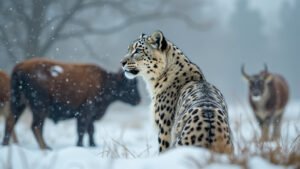Introduction
The illegal wildlife trade poses one of the most significant threats to the survival of snow leopards, the elusive big cats of Central and South Asia’s mountainous regions. Poached for their beautiful pelts, bones, and other body parts, snow leopards are targeted by a lucrative black market that operates both locally and internationally
The consequences of this illegal trade are dire, leading to population declines, disruption of social structures, and the potential for extinction if current trends continue. This article will delve into the reasons snow leopards are targeted by poachers, the devastating impact on their populations, the legal frameworks in place to protect them, and the conservation strategies being implemented to combat this critical issue
Reasons Snow Leopards Are Targeted by Poachers
Snow leopards, known for their elusive nature and majestic beauty, are increasingly becoming targets for poachers due to the high value placed on their pelts, bones, and other body parts
This illegal trade is driven by various factors, including demand in the fashion and traditional medicine industries, as well as economic pressures faced by local communities living in snow leopard habitats. Understanding these motivations is crucial to addressing the root causes of poaching and developing effective conservation strategies
Demand for Pelts and Bones
One of the primary reasons snow leopards are targeted by poachers is the high demand for their pelts. The thick, soft fur of the snow leopard is prized for its beauty and is often used in the production of luxury garments and accessories
These pelts can fetch high prices on the black market, making them a lucrative commodity for those involved in illegal wildlife trade. The fashion industry, particularly in parts of Asia and Europe, has historically been a major driver of this demand, with snow leopard fur being used to create coats, hats, and other items that are considered status symbols
In addition to their pelts, snow leopard bones and other body parts are highly sought after for use in traditional medicine, particularly in parts of Asia. These body parts are believed to have various medicinal properties, including treating rheumatism and enhancing strength and vitality
Although these beliefs are not supported by scientific evidence, the demand for traditional remedies remains strong, contributing to the ongoing poaching of snow leopards. The bones of snow leopards are often ground into powders or used to create tinctures, which are then sold at high prices, further incentivizing illegal hunting
Cultural and Medicinal Uses
Cultural practices and beliefs also play a significant role in the poaching of snow leopards. In some communities, snow leopard pelts are used in traditional ceremonies or as symbols of status and power
For example, in certain regions of Central Asia, wearing a snow leopard pelt is seen as a sign of wealth and social standing. These cultural uses create a steady demand for snow leopard pelts, perpetuating the cycle of poaching and illegal trade
The use of snow leopard parts in traditional medicine is deeply rooted in cultural practices, particularly in countries like China, where traditional Chinese medicine (TCM) has a long history
Despite international efforts to curb the use of endangered species in medicine, the belief in the healing properties of snow leopard parts persists. This ongoing demand places immense pressure on snow leopard populations, as poachers continue to hunt these animals to supply the market
Economic Pressures in Local Communities
The economic pressures faced by local communities living in or near snow leopard habitats also contribute to the poaching problem. Many of these communities are located in remote, impoverished areas where opportunities for economic advancement are limited
The high prices offered for snow leopard pelts and body parts provide a tempting source of income for individuals who may otherwise struggle to make a living
Livestock predation by snow leopards further exacerbates the situation. In many cases, snow leopards prey on domesticated animals, such as goats and sheep, which are essential to the livelihoods of local herders
When a snow leopard kills livestock, it can have a devastating financial impact on a herder’s family. In response, some herders resort to retaliatory killings or sell the carcass to traders as a way to recoup their losses. This not only increases the threat to snow leopards but also creates a cycle of conflict between humans and these big cats
Efforts to reduce economic pressures on these communities, such as providing alternative sources of income or implementing livestock insurance schemes, are crucial to mitigating the impact of poaching
Conservation programs that involve local communities in the protection of snow leopards, such as eco-tourism initiatives or compensation schemes for livestock losses, have shown promise in reducing the incentive to poach and fostering a sense of stewardship over the local wildlife
Impact of Poaching on Snow Leopard Populations
The illegal poaching of snow leopards has severe consequences for their populations, threatening not only the survival of individual animals but also the stability of the entire species
The impact of poaching extends beyond immediate population declines, leading to long-term challenges that affect genetic diversity, social structures, and the overall health of ecosystems where snow leopards play a crucial role
Population Decline and Genetic Diversity
Poaching has a direct and devastating impact on snow leopard populations. With fewer than 7,000 snow leopards remaining in the wild, every individual lost to poaching represents a significant blow to the species
The removal of breeding adults from the population can lead to reduced reproductive rates, further accelerating the decline in numbers. This is particularly concerning in areas where snow leopard populations are already fragmented and isolated
As poaching reduces the number of snow leopards in a given area, it also impacts genetic diversity. Genetic diversity is crucial for the long-term survival of any species, as it allows populations to adapt to changing environmental conditions and resist diseases. When populations are small and isolated, inbreeding becomes more common, leading to a decrease in genetic diversity
This, in turn, makes the population more vulnerable to environmental changes, diseases, and other threats. The loss of genetic diversity due to poaching could lead to an “extinction vortex,” where small populations spiral toward extinction due to their inability to adapt
Disruption of Social Structures
Snow leopards are solitary animals with complex social structures that are influenced by factors such as territory, prey availability, and reproductive cycles. Poaching disrupts these social structures in several ways
When a dominant adult is killed, it creates a vacuum in the social hierarchy, leading to increased competition and conflict among the remaining individuals. This can result in more frequent territorial disputes and even further deaths as snow leopards fight to establish dominance
The loss of key individuals, such as experienced hunters or mothers raising cubs, can also have ripple effects throughout the population. For example, when a mother snow leopard is poached, her cubs are left without protection and guidance, significantly reducing their chances of survival
These disruptions can lead to a breakdown in the normal social order, further destabilizing the population and reducing its resilience to other threats
Long-Term Consequences for the Species
The long-term consequences of poaching on snow leopards extend beyond the immediate loss of individuals
Over time, sustained poaching pressure can lead to population bottlenecks, where the number of breeding individuals becomes so low that the population cannot recover even if poaching is reduced. This scenario increases the risk of local extinctions, particularly in areas where snow leopards are already living in fragmented habitats
Furthermore, the decline in snow leopard populations has broader ecological implications. Snow leopards are apex predators, meaning they play a crucial role in maintaining the balance of their ecosystems. By controlling the population of herbivores such as blue sheep, ibex, and Himalayan tahr, snow leopards help prevent overgrazing and ensure the health of alpine and subalpine ecosystems
When snow leopard numbers decline due to poaching, these prey populations can increase unchecked, leading to habitat degradation and a cascade of negative effects on biodiversity
The loss of snow leopards from an ecosystem also disrupts the intricate relationships between predators, prey, and vegetation. This can result in altered food webs, changes in species composition, and reduced ecosystem resilience
In the long run, the impact of poaching on snow leopards can lead to the collapse of entire ecosystems, with far-reaching consequences for biodiversity and the people who depend on these environments for their livelihoods
Legal Protections and Enforcement Challenges
Snow leopards are protected under various international and national laws designed to curb illegal wildlife trade and poaching
However, the effectiveness of these legal frameworks is often hampered by enforcement challenges, including limited resources, corruption, and the vast, remote areas where snow leopards live. Understanding the legal protections in place and the difficulties in enforcing them is crucial for improving conservation efforts and reducing poaching
International and National Laws
Snow leopards are listed as vulnerable under the International Union for Conservation of Nature (IUCN) Red List and are protected by several international agreements
The most significant of these is the Convention on International Trade in Endangered Species of Wild Fauna and Flora (CITES), which classifies snow leopards under Appendix I. This designation means that all international trade in snow leopards, their pelts, bones, and other body parts, is prohibited except under exceptional circumstances, such as scientific research
In addition to CITES, snow leopards are protected by national laws in the 12 countries that make up their range, including China, India, Mongolia, and Nepal. These countries have implemented various legal measures, such as banning hunting and establishing protected areas, to safeguard snow leopard populations
For example, in India, the snow leopard is listed under Schedule I of the Wildlife Protection Act, which provides the highest level of protection and imposes severe penalties for poaching or trafficking
Despite these legal protections, the effectiveness of laws varies significantly from country to country. In some regions, laws are robust and well-enforced, while in others, enforcement is weak or inconsistent, making it difficult to curb poaching and illegal trade effectively
Challenges in Law Enforcement
Enforcing laws designed to protect snow leopards is a complex and often daunting task. One of the primary challenges is the remote and rugged terrain where snow leopards live
These areas are difficult to access, and patrolling them requires significant resources, including trained personnel, equipment, and logistical support. The vastness of these habitats makes it challenging to monitor and apprehend poachers, who often operate with relative impunity in these isolated regions
Corruption is another significant obstacle to effective law enforcement. In some countries, poachers and traffickers bribe officials to turn a blind eye to illegal activities or to obtain permits for hunting and trade under false pretenses. This corruption undermines conservation efforts and allows the illegal trade in snow leopards to continue unabated
Additionally, the penalties for poaching and trafficking in some regions are not severe enough to deter illegal activities
Even when poachers are caught and prosecuted, the fines and sentences imposed are often minimal compared to the potential profits from selling snow leopard pelts and parts. This lack of stringent punishment perpetuates the cycle of poaching and illegal trade
Another challenge is the lack of adequate funding and resources for conservation and law enforcement agencies. In many snow leopard range countries, these agencies operate with limited budgets, making it difficult to carry out effective anti-poaching operations, conduct regular patrols, or invest in advanced monitoring technologies
This resource gap hinders the ability to respond swiftly to poaching incidents and reduces the overall effectiveness of law enforcement efforts
Role of Anti-Poaching Organizations
Despite the challenges, several organizations are working tirelessly to combat poaching and protect snow leopards
International NGOs like the Snow Leopard Trust and Panthera, as well as local conservation groups, collaborate with governments and local communities to enhance enforcement efforts. These organizations provide crucial support, including funding, training, and equipment, to improve the capacity of law enforcement agencies
Anti-poaching initiatives often involve a combination of strategies, such as community engagement, intelligence gathering, and the use of technology
For example, camera traps, drones, and GPS tracking collars are increasingly being used to monitor snow leopard populations and detect poaching activities. These technologies allow for more effective surveillance and can help authorities respond more quickly to illegal activities
Community-based conservation programs also play a vital role in reducing poaching. By involving local communities in conservation efforts and providing them with economic incentives, such as eco-tourism or livestock insurance schemes, these programs help to reduce the reliance on poaching as a source of income. When local people see the value of protecting snow leopards, they are more likely to cooperate with law enforcement and report illegal activities
Conservation Strategies to Combat Illegal Trade
Efforts to combat the illegal trade of snow leopards encompass a range of strategies, from community engagement and education to technological innovations and international collaborations
These conservation strategies aim not only to prevent poaching but also to address the underlying socioeconomic factors that contribute to illegal activities. By implementing multifaceted approaches, conservationists strive to create sustainable solutions that ensure the long-term survival of snow leopards
Community-Based Conservation Initiatives
One of the most effective strategies in combating illegal trade involves engaging local communities in conservation efforts
Recognizing that these communities are often the first line of defense against poaching, conservation programs focus on empowering residents to become stewards of their natural environment:
Livestock Insurance and Compensation Schemes: Since snow leopards occasionally prey on livestock, which can lead to significant economic losses for herders, implementing livestock insurance programs can mitigate retaliatory killings
These schemes provide financial compensation to herders for livestock losses attributed to snow leopards, reducing the incentive to harm these predators. For example, the Snow Leopard Trust’s Livestock Insurance Program has been successful in several countries, fostering coexistence between humans and snow leopards
Alternative Livelihood Programs: Providing alternative sources of income reduces the economic pressures that may drive individuals to participate in poaching. Initiatives such as handicraft production, eco-tourism, and sustainable agriculture offer viable economic opportunities
The Snow Leopard Enterprises program, for instance, enables community members to produce and sell handicrafts, with a portion of the profits reinvested into local conservation efforts
Education and Awareness Campaigns: Raising awareness about the importance of snow leopards and the consequences of illegal trade is crucial. Educational programs in schools and communities highlight the ecological role of snow leopards and promote a sense of pride and ownership over local wildlife. By fostering positive attitudes towards conservation, these campaigns help reduce poaching and trafficking
Technology and Monitoring Tools
Advancements in technology have provided conservationists with new tools to monitor snow leopard populations and detect illegal activities more effectively:
Camera Traps: Deploying camera traps in strategic locations allows for non-invasive monitoring of snow leopard populations
These cameras capture images and videos of snow leopards in their natural habitats, providing valuable data on their numbers, behavior, and movements. Additionally, the presence of camera traps can act as a deterrent to poachers who fear detection
GPS Tracking Collars: Fitting snow leopards with GPS collars enables researchers to track their movements in real-time
This information helps identify critical habitats, migration corridors, and potential conflict zones. Understanding these patterns aids in deploying anti-poaching patrols more effectively and in making informed decisions about habitat protection
Drones and Aerial Surveillance: Utilizing drones for aerial surveillance offers a cost-effective means to monitor vast and inaccessible terrains
Drones can cover large areas quickly, detect illegal activities, and gather data on snow leopard habitats. This technology enhances the ability of law enforcement agencies to respond promptly to poaching incidents
International Collaboration and Policy Enforcement
Given that snow leopard habitats span across multiple countries, international collaboration is essential in combating illegal trade:
Transboundary Cooperation: Neighboring countries share information, resources, and strategies to monitor and protect snow leopard populations that traverse international borders. Initiatives like the Global Snow Leopard and Ecosystem Protection Program (GSLEP) facilitate such cooperation, aiming to secure 20 snow leopard landscapes by 2020 through collaborative efforts
Strengthening Legal Frameworks: Working with governments to enhance wildlife protection laws and ensure their rigorous enforcement is critical. This includes imposing stricter penalties for poaching and trafficking, improving judicial processes, and ensuring that wildlife crimes are treated as serious offenses
Capacity Building: Training law enforcement officials, rangers, and customs officers improves their ability to detect and prevent illegal trade. Workshops, seminars, and field training programs equip these personnel with the necessary skills and knowledge to combat wildlife crime effectively
Public-Private Partnerships: Collaborating with businesses, especially those in the fashion and traditional medicine industries, helps in reducing demand for snow leopard products. Encouraging corporate responsibility and promoting the use of sustainable and ethical alternatives can significantly diminish the market for illegally sourced materials
Conclusion
The illegal wildlife trade poses a critical threat to the survival of snow leopards, one of the most iconic and endangered species in the world
Driven by the demand for their pelts, bones, and other body parts, poaching has led to significant declines in snow leopard populations, disrupting social structures and reducing genetic diversity. Despite the existence of international and national legal protections, enforcement challenges such as corruption, resource limitations, and the remote nature of snow leopard habitats have allowed this illegal trade to persist
However, conservation strategies offer hope. Community-based initiatives that engage local residents in protecting snow leopards, along with technological advancements like camera traps and GPS tracking, are making a difference
International collaboration and stronger enforcement of wildlife protection laws are also crucial in this fight. To ensure the future of snow leopards, it is essential to continue these efforts, addressing both the root causes of poaching and the complexities of illegal trade. By doing so, we can work towards a world where snow leopards not only survive but thrive in their natural habitats











